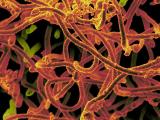Apr 7, 2005 (CIDRAP News) As the record-setting outbreak of deadly Marburg hemorrhagic fever in Angola continued to grow, the World Health Organization (WHO) said yesterday that the legacy of a decades-long civil war poses major challenges to containment efforts.
The WHO said the epidemic, now significantly larger than the worst previous Marburg outbreak, is the first in an urban setting. Fighting the disease is difficult, the agency said, because Angola has a very weak health infrastructure, poor communication and transportation systems, and an impoverished population.
The WHO said Angolan officials put the size of the outbreak as of Apr 5 at 181 cases, 156 of them fatal, with the northern city of Uige still the epicenter. An Agence-France Presse (AFP) story published yesterday reported 159 deaths. Earlier reports said about 75% of patients were children under the age of 5, but the proportion of adults has been increasing recently, the WHO said.
In view of its experience in fighting Ebola fever, the WHO said it is still confident that the Marburg outbreak can be controlled. However, "the implementation of effective control measures faces several significant challenges, some of which may be unique to this outbreak."
The largest previous Marburg outbreak caused 149 cases with 123 deaths in the Democratic Republic of the Congo between 1998 and 2000. That outbreak "was confined to two sparsely populated villages in an isolated corner of the country, caused sporadic cases with small chains of transmission over two years, and never reached the intensity of transmission seen in just the past few weeks in Angola," the WHO said.
"The outbreak in Angola is not only the largest on record, with the highest fatality, but is also the first to occur in an urban setting," the statement said.
It continued, "Almost three decades of civil unrest have left Angola with a severely weakened health infrastructure, a hospital system in dire need of basic equipment and supplies, inadequate communication and transportation systems, and a population weakened by economic hardship. These weaknesses hamper containment efforts, which depend on active surveillance for cases, rapid detection and isolation in specially designated and equipped facilities, and rapid tracing of contacts."
The agency said containment efforts depend on good communication and transportation systems, which don't exist in Angola. To make matters worse, hundreds of thousands of landmines are believed to remain in the country, necessitating air transport of staff and equipment.
A key goal of the containment effort is to prevent the disease from gaining a foothold in "densely populated urban or peri-urban parts of the country," the WHO said. "For example, Uige, which is presently the epicentre of the outbreak, has around 500,000 inhabitants, but Luanda [the capital], where some cases have been reported, has a population close to 3 million. Response capacity in Luanda is being strengthened by the Ministry of Health, and WHO is increasing the number of international staff there as a support."
A week ago officials said 12 healthcare workers were among those infected. The WHO said those cases "point to the need to greatly increase supplies of protective equipment for front-line workers," particularly in Uige and Luanda. The agency said it had sent three shipments of equipment, with more on the way, and supplies are also coming from the US Centers for Disease Control and Prevention (CDC), Medicines sans Frontieres (MSF), and UNICEF. But supplies still fall short of the need.
Further, the disease causes great fear, which may cause people to flee to other areas, fanning the spread of the outbreak, the WHO said. "In Uige, there is some evidence of a reluctance to seek treatment or remain under care in hospitals. Efforts are urgently needed to strengthen the hospital system, restore public confidence, and thus improve compliance with control measures."
Yesterday Angola's national assembly passed a resolution asking President Eduardo dos Santos's government for rapid measures to combat the outbreak, according to the AFP report. The story said dos Santos created an emergency commission led by the interior minister to deal with the disease.
More than 30 international experts, most of them from the WHO, CDC, and MSF, have flown to Angola since the disease first broke out last October, AFP reported. Most have gone to Uige, about 180 miles north of Luanda. MSF officials told AFP that isolation wards were operating in both Uige and Luanda.
Luanda's health director said laboratories now operating in Angola make it possible to diagnose the disease in 2 days, instead of the 3 weeks it took previously to send samples to the CDC and get word back, according to the story.
There is no vaccine or cure for Marburg fever, which is clinically very similar to Ebola fever. The illness features severe headache and malaise, high fever, severe diarrhea, abdominal pain and cramping, nausea, and vomiting, among other symptoms. Many patients have bleeding in the gastrointestinal system and at other sites starting about 5 days into the illness, according to the WHO. In fatal cases, death usually occurs after 8 or 9 days. The virus spreads through contact with bodily fluids of infected people.
See also:
Apr 6 WHO update
http://www.who.int/csr/don/2005_04_06/en/
WHO fact sheet on Marburg hemorrhagic fever
http://www.who.int/csr/disease/marburg/factsheet/en/













